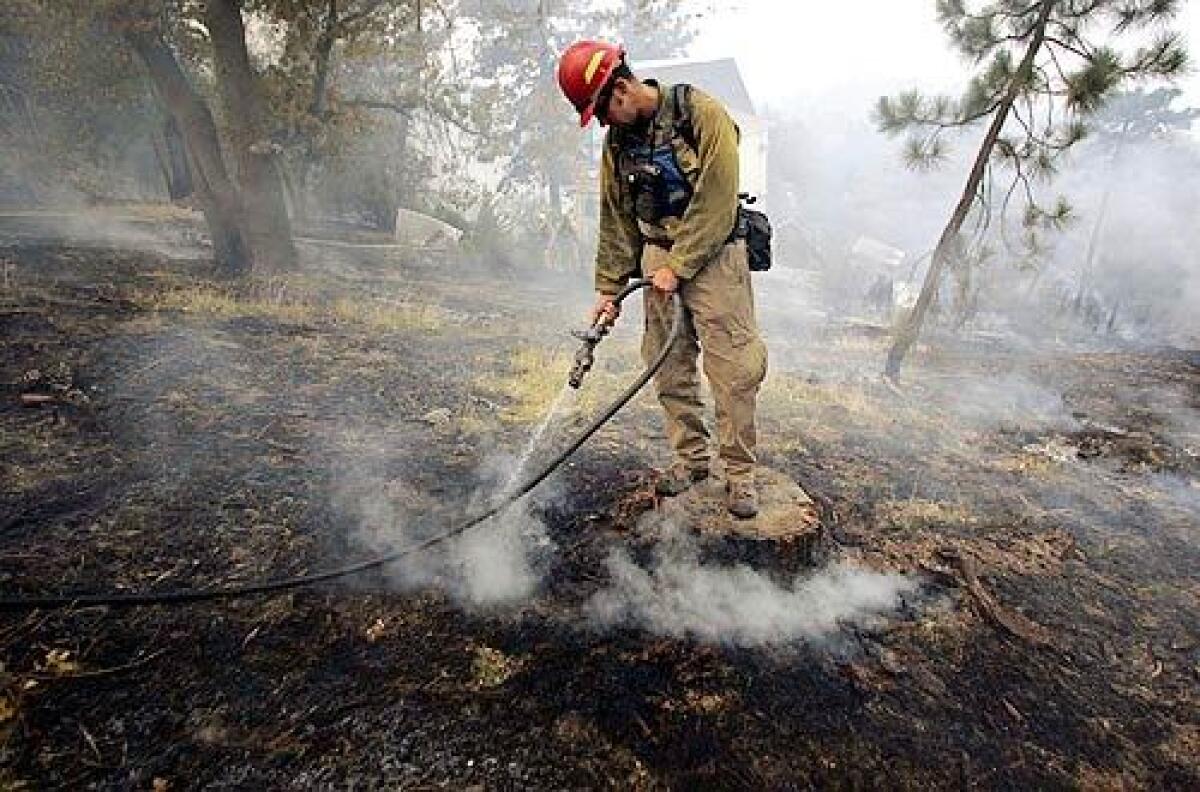2 blazes are still raging in the mountains

- Share via
While thousands of neighbors fled the burning mountains around him, Scott Garrett ignored a mandatory evacuation order to try to save his 6,000-square-foot home on a hillside west of Lake Arrowhead. Inside: a stash of movie memorabilia, including a large winged angel statue from the Ben Affleck movie “Daredevil” and a costume from “Planet of the Apes.”
Garrett, 48, a semiretired movie studio art department technician, filled large buckets with water and sprayed his wood deck with fire retardant. As embers pelted the deck of his Grass Valley home, he swept them away before they could take hold. Using a garden hose, he battled smoldering trees and bushes.
He was ready to leave when “all the houses started burning and exploding, all the ammunition and propane going off,” he said. “I saw my neighbor, and we decided to stay. I’m glad I did.”
Garrett was doing battle with one of two fires that continued to rage Tuesday near Lake Arrowhead, burning 5,000 acres total, with more than 300 homes destroyed, more than 15,000 people forced to evacuate and 10,000 homes threatened.
In the west, the Grass Valley fire had burned 1,000 acres and destroyed 113 homes and businesses, but fire officials said it was 30% contained. About 10 miles east, the Slide fire had burned 4,000 acres and more than 200 homes. Firefighters worried that the wind could blow the fires together, a scenario that U.S. Forest Service Battalion Chief Steve Seltzner said “could be catastrophic.”
Ken Larson, a fire behavior analyst with the U.S. Forest Service, said, however, that he thought the worst was over. The winds are expected to shift Thursday and Friday, coming from the west rather than the northeast, increasing humidity levels and reducing the fire threat.
Gov. Arnold Schwarzenegger visited one of the flame-ravaged neighborhoods on the eastern edge of the Grass Valley fire to view the damage Tuesday.
Flanked by fire officials, he peered through charred trees and walked quietly past homes that were obliterated, except for brick chimneys.
At a news conference, Schwarzenegger said he had spoken to President Bush and alerted him to the possible need for federal aid in the damaged areas. “It’s really sad and heartbreaking,” the governor said. “People have worked hard and saved all their money for years, and in one hour to the next, their homes are destroyed.”
Meanwhile, about 10 miles east, firefighters had no success containing the Slide fire, said Deputy Chief Dan Wurl of the San Bernardino County Fire Department.
On Valley Ridge Drive in Running Springs, firefighter Richard Valenzuela of the Brawley Fire Department stood in front of a green house with red wooden stairs, dousing smoldering lawn chairs and tree stumps. He and his partner had stood guard on either side of the home to protect it from the flames Monday night.
“This is the house we saved,” Valenzuela said with pride. “We were out here all night.”
Although the blaze jumped over California 330, increasing the risk to communities to the south, firefighters were heartened by the fire’s movement from areas of dense timber into regions with lighter vegetation that had burned at least twice in less than 10 years, including during the devastating Old fire in 2003.
Northeast of Running Springs, in Green Valley Lake, a small mountain town of about 750 people, at least 55 homes surrounding the picturesque alpine lake were destroyed.
A local water official, Rick Mull, moved between burned-out houses, lifting the heavy lids off water meters and turning off each home’s water system.
“Many folks took up and left in a panic and forgot to turn their water off,” Mull said. That meant water that could have supplied firefighters’ tanks was flowing freely at the ruined homes. “In the last few days, we’ve gone through 400,000 gallons of water on just one neighborhood street because of leaking pipes.”
Mandatory evacuations were in place throughout much of the San Bernardino Mountains from Snow Valley Lake west to the Valley of Enchantment, including all of Lake Arrowhead. Not everyone heeded the warnings.
Gazing across Cedar Glen Canyon, near Lake Arrowhead, where 350 homes were destroyed in 2003, Jack Fuller stood on his balcony with neighbor Shane McLelland and studied the fire less than a mile away. They were among 50 people who chose to stay and protect their homes, most of which had been built in the last four years.
“The fire is going to come through here, possibly take away all these new homes and then head into Lake Arrowhead. So we’ve got our hoses laid out and ready,” McLelland said. “We’re not going to let our homes burn again if we can help it.”
By Tuesday, the number of evacuees at the Orange View Fairgrounds in San Bernardino had grown to nearly 1,500 from about 900 Monday night, many of them from the burned areas near Lake Arrowhead.
Just south of Running Springs, the fire decimated the community of Fredalba. There simply were not enough fire trucks to chase down the fire that swept into the city Tuesday morning, said Brian Savage, a division supervisor with the Culver City Fire Department.
The clutter left by homeowners around their wooded yards quickened the fire’s pace.
“You tell people to do clearance, and they think it’s OK to leave the wood piles and the sheds. That stuff starts burning and it’s right up next to the house,” Savage said. “They just don’t get it.”
christopher.goffard @latimes.com
Times staff writer Francisco Vara-Orta and staff photographer Robert Gauthier contributed to this report.
More to Read
Sign up for Essential California
The most important California stories and recommendations in your inbox every morning.
You may occasionally receive promotional content from the Los Angeles Times.












